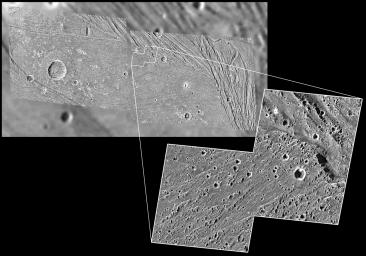
|
Not-so-smooth Bright Terrain of Harpagia Sulcus
- Click the image above for a larger view
- Full-Res JPEG (3328 x 2330) (966.7 kB)
- Full-Res TIFF (3328 x 2330) (4.3 MB)
Caption:
The highest-resolution images ever obtained of Jupiter's moon Ganymede show that even smooth-looking terrain has been deformed at a fine scale.
The high-resolution image taken of the bright Harpagia Sulcus area by NASA's Galileo spacecraft during a May 20, 2000, flyby of Ganymede shows features as small as 16 meters (52 feet). This area was selected for a closer look because, in images taken by NASA's Voyager spacecraft about 20 years earlier, it looked as flat as a hockey rink. It appears smooth even in a medium-resolution Galileo image (at 116 meters or 380 feet per pixel) that is superimposed over a Voyager image in the top portion of this frame. But the closeup shot revealed that, instead of a hockey rink, the area has ups and downs that would be challenging for across-country skier.
North is to the top of the picture and the Sun illuminates the surface from the left. The medium-resolution image mosaic is centered at -16degrees latitude and 310 degrees longitude, and covers an area approximately 282 by 144 kilometers (175 by 89 miles).
Background Info:
This image and other images and data received from Galileo are posted on the Galileo mission home page at http://www.jpl.nasa.gov/galileo . Background information and educational context for the images can be found at http://www.jpl.nasa.gov/galileo/sepo
The Jet Propulsion Laboratory, a division of the California Institute of Technology in Pasadena, manages the Galileo mission for NASA's Office of Space Science, Washington, D.C.
This image was produced by DLR (German Aerospace Center), Berlin, and Brown University, Providence, R.I., http://solarsystem.dlr.de/ and http://www.planetary.brown.edu/ .
Cataloging Keywords:
| Name | Value | Additional Values |
|---|---|---|
| Target | Ganymede | |
| System | Jupiter | |
| Target Type | Satellite | |
| Mission | Galileo | Voyager |
| Instrument Host | Galileo Orbiter | |
| Host Type | Orbiter | Flyby Spacecraft |
| Instrument | Solid-State Imaging (SSI) | |
| Detector | ||
| Extra Keywords | Grayscale | |
| Acquisition Date | ||
| Release Date | 2000-12-16 | |
| Date in Caption | 2000-05-20 | |
| Image Credit | NASA/JPL/Brown University | |
| Source | photojournal.jpl.nasa.gov/catalog/PIA02581 | |
| Identifier | PIA02581 | |
